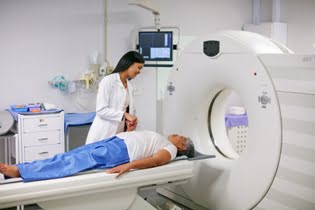Indications for MRI Dorsal/Dorso-Lumbar Spine Without Contrast
1] Degenerative Disc Disease: Over time, the intervertebral discs that separate the vertebrae can wear down, leading to pain and stiffness. MRI can detect the extent of disc degeneration and help plan appropriate treatment.
2] Herniated or Bulging Discs: In cases where a disc between vertebrae has been displaced or ruptured, MRI can identify the position and size of the herniation and its potential impact on nearby nerves.
3] Spinal Stenosis: This condition involves the narrowing of the spinal canal, which can compress the spinal cord or nerves. MRI can show the degree of narrowing and guide treatment decisions.
4] Spondylolisthesis: This occurs when one vertebra slips out of place over the vertebra below it. MRI can help visualize the alignment of the vertebrae and assess any related nerve compression.
5] Spinal Fractures or Trauma: MRI is effective at detecting fractures in the spine, particularly in the soft tissues and ligaments, even when there are no obvious fractures seen on X-rays.
6] Spinal Infections or Tumors: While an MRI without contrast is not ideal for detecting tumors, it can still show any mass or abnormal growth that could be indicative of infection or a benign tumor.
7] Sciatica and Nerve Compression: If a patient is experiencing leg pain, numbness, or weakness, an MRI of the lumbar spine can identify nerve compression due to conditions like a herniated disc or spinal stenosis.
How the Procedure Works
The MRI procedure is painless and typically takes between 20-40 minutes. The patient will be asked to lie down on a moveable table that slides into the MRI machine, which resembles a large tube. As the machine operates, it uses strong magnetic fields and radio waves to create detailed images of the spine. The patient will need to remain as still as possible during the scan to ensure the images are clear.
The MRI machine produces cross-sectional images that allow doctors to see the spine from multiple angles. These images are then analyzed to assess any abnormalities, such as disc degeneration, fractures, or nerve impingement.
Advantages of MRI Without Contrast
1] Non-invasive: MRI does not involve surgery or radiation, making it a safer alternative to other diagnostic tests like CT scans.
2] Detailed Imaging: MRI can provide high-resolution images that reveal soft tissue details, including the spinal cord, discs, and nerves, which X-rays cannot show.
3] Avoids Contrast Risks: Since no contrast agent is used, there is no risk of allergic reactions or complications related to the contrast medium, making it suitable for individuals with kidney problems or those allergic to contrast dyes.









